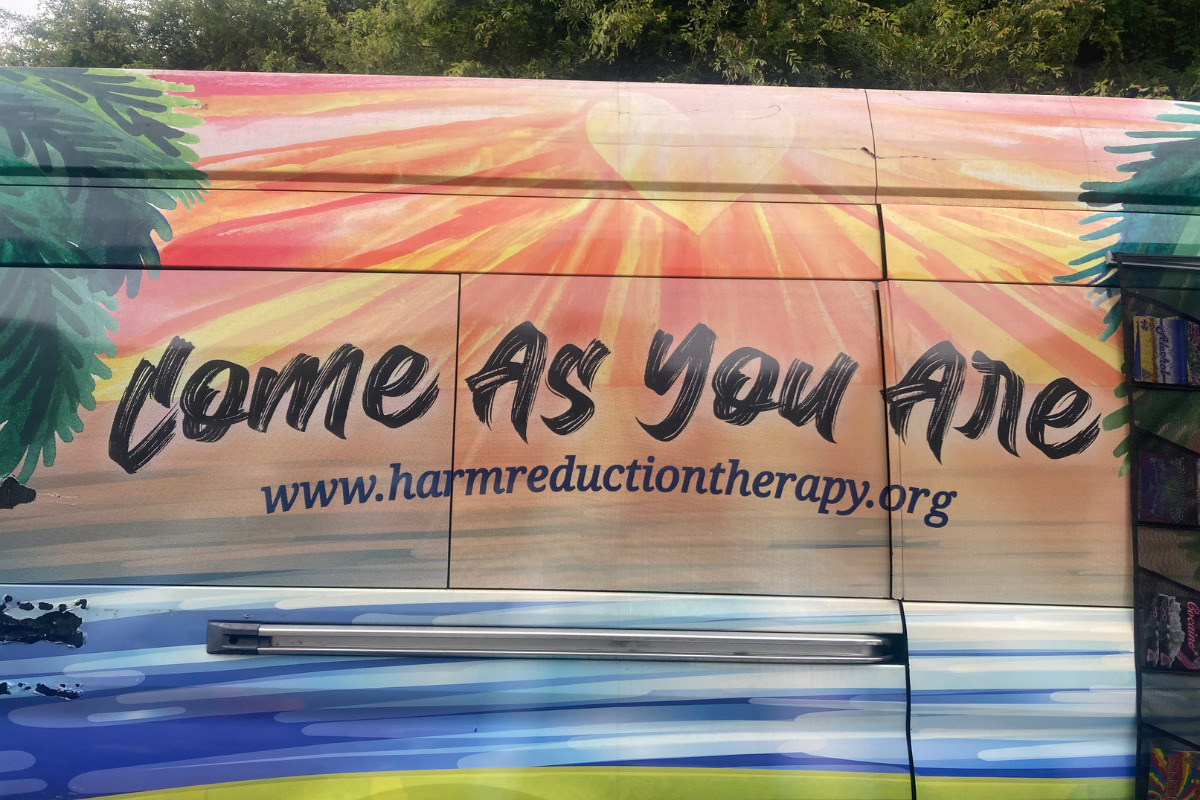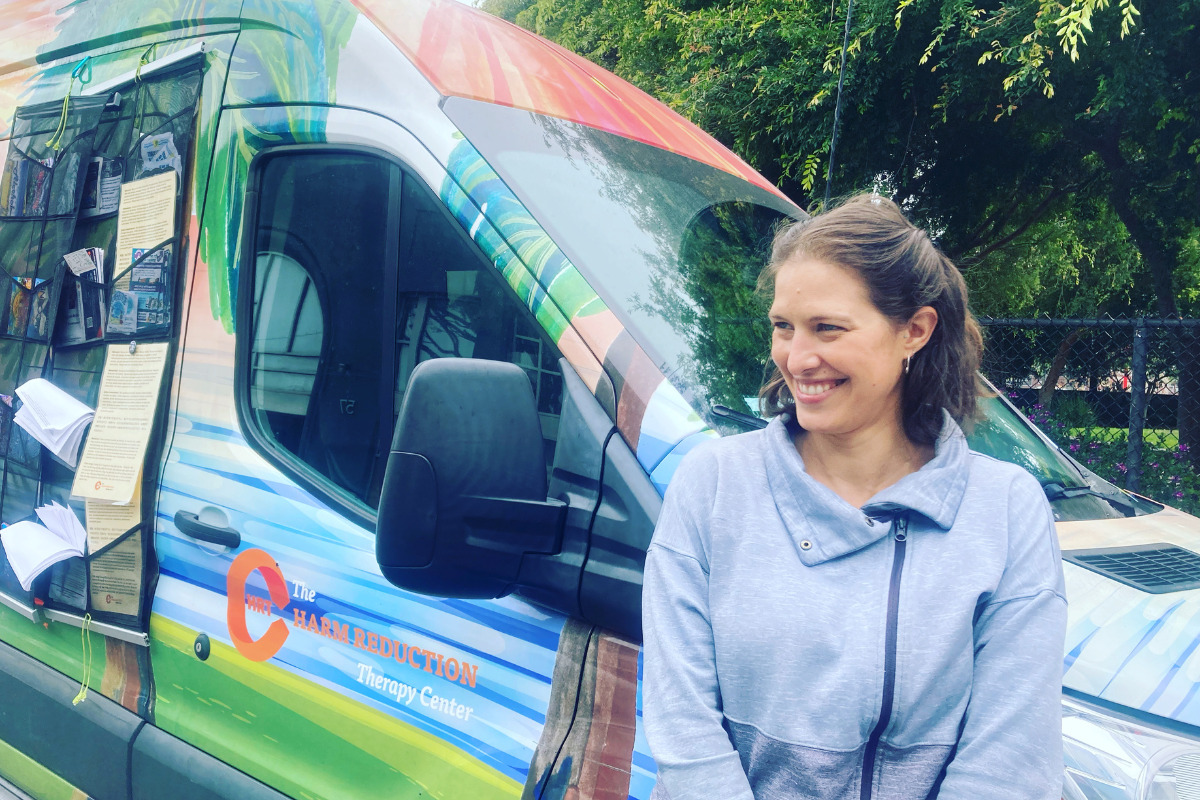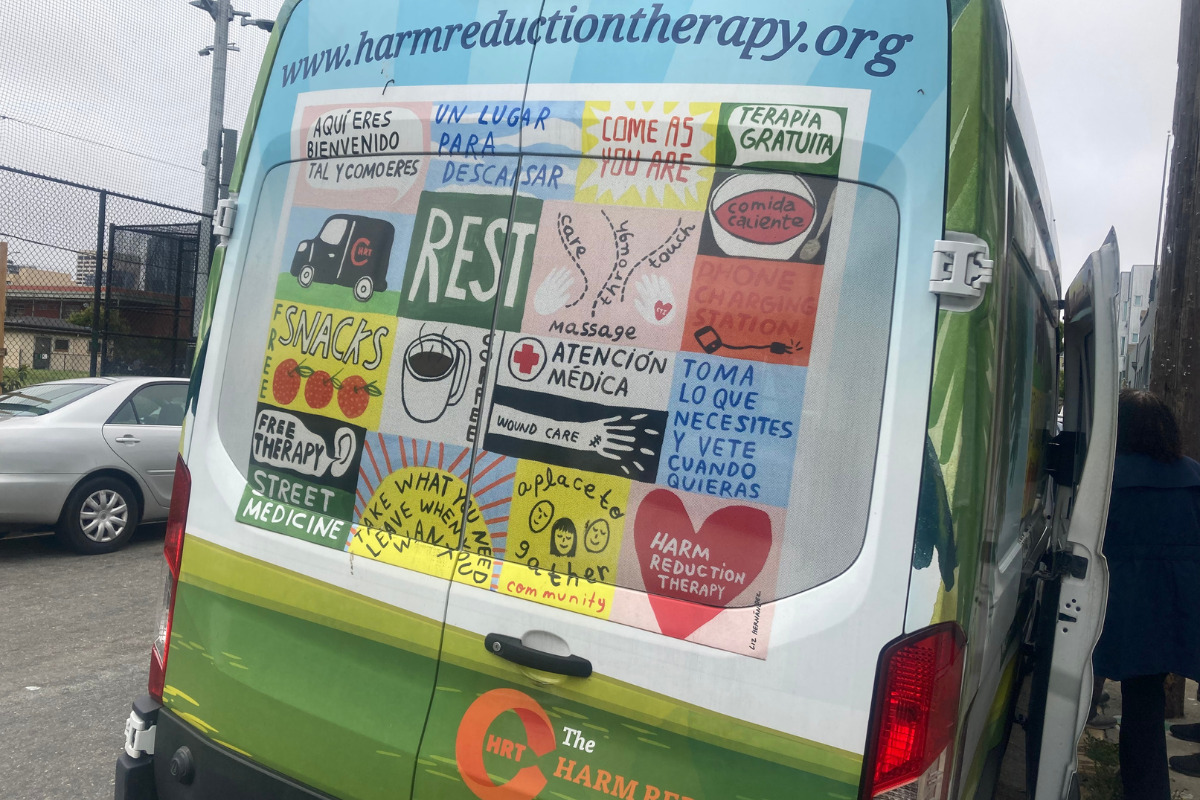
In a side street off a busy thoroughfare in San Francisco’s South of Market (SoMA) neighbourhood, dozens of people with nowhere else to go have set up home. There are tents and tarps, plywood and cardboard shelters, and trolleys full of belongings lining the alley, as traffic from the route 80 freeway thunders overhead.
For the last couple of years this street has also been home to the Harm Reduction Therapy Center (HRTC), a psychotherapy service with a difference, offering an open-door policy to people using drugs. There’s a reason they opened their first building-based drop-in centre right here.
“These are our people,” says director of programmes Anna Berg as she looks around at the encampment. “Being close, being able to be responsive to what folks are needing and to build community right where the community is… that’s what we like to do at HRTC.”
But Berg is painfully aware that many of “their people” currently find themselves in the eye of an increasingly polarised storm of debate about how to solve San Francisco’s opioid crisis.
Like many large cities across the United States, fentanyl – a cheap to make synthetic opioid – has taken hold here and the death toll is still rising. By the end of July there had been a total of 473 overdose deaths in this city – which has a population of about 800,000 – putting it on track to surpass its 2020 annual record of 725 overdose deaths.
It’s also in the grip of a housing crisis. In California, minimum-wage earners have to work nearly 90 hours a week to afford a one-bedroom apartment, a recent study found.
And then there’s the mental health element. More than 13,600 people suffering from mental illness were taken to San Francisco hospitals on an involuntary basis over a 12-month period, according to figures released this February.

The issues cannot easily be untangled. As of August 2022, government statistics showed almost half of the 19,000 people who had experienced homelessness in the last year had either a substance use or serious mental health disorder and 35 per cent had both.
When mayor London Breed – a black woman who grew up in the “chaos” of the projects and whose sister died of an overdose – was elected in 2019, there was hope that this self-described “pragmatic progressive” would have answers.
She formed SFMentalhealth in the year she took office – with a crisis-focused street team and an increase in mental health beds and treatment services. That December she declared a state of emergency in Tenderloin, the downtown area at the heart of the crisis, and a month later put funding in place for a Linkage Centre, offering respite from the street and access to support for drug users.
But eleven months later she closed the centre, claiming it wasn’t working. She called for “tough love” like involuntary treatment orders and hit out at the harm reduction-focused approach with a claim that “compassion is killing people”.
The city says it’s spending record amounts on programmes. But those working with the city’s most vulnerable claim the mayor is overly influenced by real estate owners and vocal tech giants. Meanwhile they are forced to step in to help those ricocheting from the hospital to the street, to a drug treatment service and back again.
The battle is raging in the courts too. Last week the city was denied its request to modify an order that temporarily bans the city from clearing street encampments without first offering people alternative shelter options.

Critics of the Coalition on Homelessness, which took the initial legal action, include tech giant Elon Musk who last month called for a boycott on the law firm Latham & Watkins for providing support to the not-for-profit.
But from the perspective of organisations like the Harm Reduction Therapy Centre, what’s needed is more compassion – not less – as well as work that gets to the heart of what’s driving people’s problems.
Its approach is one based on relationship building. “What is really an antidote to chaotic drug use is connection,” says Berg. “It’s community, people noticing you and welcoming you and making space for you just as you are.”
“Come as you are, take what you need, leave when you’re ready,” is HRTC’s slogan, expressing their client-knows-best philosophy and belief that whether people come to their building-based or street services – and whether they take part in talk therapy or just enjoy the food and music or pick-up clean needles – every interaction can be therapeutic.
This is a response to the catch-22 situation people turned away from mental health services because staff insisted they first needed to address their substance use – and vice versa – too often find themselves in.
That’s an ongoing issue that’s also been highlighted in Scotland for decades. In a report published last September the Mental Welfare Commission for Scotland found that people with both mental health and substance use problems were “often ‘bounced’ between mental health services and addictions services”.
It found “little awareness” of “joined-up working that people with a substance (drug or alcohol) use problem access mental health care at the point of treatment”.
Dr Arun Chopra, the commission’s medical director, told The Ferret: “Our report shows that there remains a gap in implementing what policies suggest should already be happening for this vulnerable group. Stigma, a lack of trauma-informed services and silo-working within some statutory services are real barriers.”
Third-sector organisations are key to helping reduce these barriers, he claims. But some working in frontline services are struggling to find ways around them. Despite recommendations from the Drug Deaths taskforce last July that this issue was addressed, not enough has changed according to those affected.
“From our perspective and experience there are still huge challenges around people being seen as having a ‘dual diagnosis’, “ explains Claire Longmuir, harm reduction manager of Simon Community Scotland.
“There’s an expectation for a person to be drug free or presenting as not under the influence of substances in order to engage in support around their mental health. There is a sense of needing to prove that you are ready to access mental health support through reducing or abstaining from substance use.
“The only support people receive is when it reaches crisis point and even then it can be challenging accessing appropriate, timely and trauma-informed care.”
Meanwhile in San Francisco, HRTC co-founder Patt Denning explains it was this very problem that led her to set up the centre more than two decades ago. Her background was in therapy but her work with HIV patients in 1980s San Francisco brought her into contact with the difficulties people using drugs were having getting help. The “inhumane” treatment on offer shocked her.
“They used to say in treatment, you can either be crazy or an addict, but you can’t be both,” she says wryly. The division between problematic substance use and mental ill health, she insists, is a wholly unhelpful one. “It’s a very false distinction.”
Stigma, a lack of trauma-informed services and silo-working within some statutory services are real barriers.
Dr Arun Chopra, Mental Welfare Commission for Scotland
The approach she and fellow founder Jeannie Little took was to offer “radical hospitality” and to make therapy appealing and relevant to the lives of those whom they wanted to serve.
As a therapist, she says, that means not turning anyone away as they might be in more traditional therapeutic services. “That sense of inclusion extends to the environment,” she says. “So we make sure that people’s entry into the place is as welcoming as possible.
“If there’s a front desk person they are specifically trained to accept anybody who walks in the door.” Bright colours, comfortable furniture and good food all send signals to people that they belong, she says.
Regular clinics are held on the street, including a longstanding one on Wednesday afternoon next to a small park off Fulsom and 6th Street. Here, people living on the streets, in the nearby homeless shelters and hotels, or even just in the neighbourhood, can pick up food or harm reduction supplies and enjoy the onsite R&B tunes, explains street therapist Jose Morilla. He considers these simple interactions as a “window” allowing the onsite therapists to build relationships.
If someone wants to talk, he is one of five therapists on stand-by, who can provide a session on the street corner, at a nearby picnic bench or even while taking a walk around the park.
“The best benefit is that we meet people where they are at,” Morillla explains. “We don’t have to go through a process of setting up an appointment or the bureaucracy of having people check in at a clinic. A lot of people have done that already. And for many reasons, it didn’t work.”
Meanwhile this approach not only has an impact on their mental health, he says, but also on their substance use. “Over time you’ll see people reducing the harms, either cutting back on substances or doing it in a safer way, where there’s less risks,” he says. “Sometimes we see people who quit substance use and go into some type of rehab.”

Anna Berg, who was a therapist at this street service before taking over as programme director, explains that her frustration with the city’s approach is that it seems uninterested in getting to the root causes of the crisis, such as trauma.
The increased rise in overdose deaths are “absolutely devastating,” she says. “And the response is ‘oh, it’s fentanyl – fentanyl everywhere’. And yes, absolutely, there’s a lot of fentanyl here in San Francisco. That is a big part of the problem.
“But we should be asking ‘why are people using? What are the conditions that help folks change?’ These things are complicated and we want to offer some connection points where folks can talk about all of that.”
She’s also painfully aware of the limitations of what they can do in the face of crisis with a small team and limited funding. When the Linkage Centre in Tenderloin was open they were funded to provide just one therapist even though about 300 people were using the space most days.
But she hopes its approach of radical inclusion can inspire change. “Today we’re on the street beside a park,” she says. “We’re talking and creating community and everybody is okay. Everybody’s got space. Everybody can have room. Everybody in the neighbourhood is welcome.
“And we like to model that in hopes that our neighbours – and our city – can remember that everybody matters, everyone is important.”
The San Francisco audio package was edited by Flora Zajicek. Find out more about this story, and other solutions to health inequalities, by listening to our podcast: The Ferret investigates… the Health Gap.
This article is part of our Mind the Health Gap project, funded by the European Journalism Centre, through the Solutions Journalism Accelerator – a fund supported by the Bill & Melinda Gates Foundation.














